Featured in NPR Blog
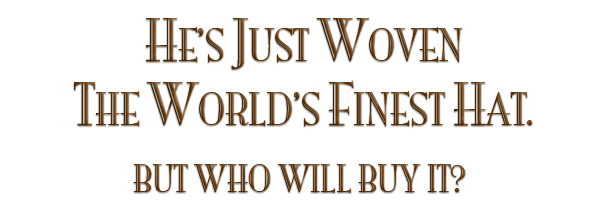
August 8,2015
By Roff Smith
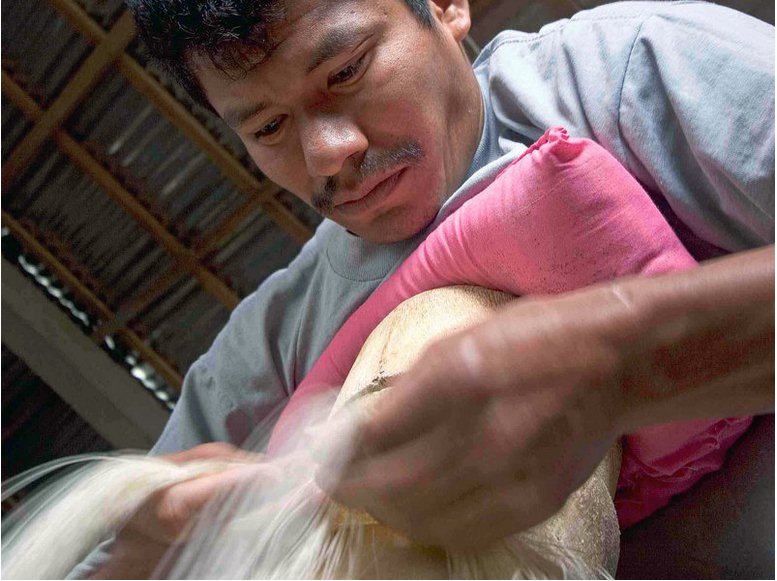
Simon Espinal has woven what is perhaps the finest Panama hat in haberdashery history. Roff Smith for NPR.
Early one morning in June, a Panama hat weaver named Simon Espinal sat down to work at a wooden table in his house in Pile, an obscure village hidden in the hills near Montecristi, in Ecuador's steamy coastal lowlands.
Selecting eight threadlike strands of toquilla straw from a special stock of extraordinarily fine straw he had spent three weeks preparing, he separated them into four matched pairs with which he formed the cruzado— the crossed threads — that is the start of every Panama hat.
And then he began to weave.
Over the coming days, then weeks, then finally months, the Panama hat he began that morning spread and grew. The cruzado evolved into the plantilla,the saucer-size crown of the hat, and then the copa, the sides of the hat, which takes shape around a block of lightweight caco wood that serves as a mold.
Summer segued into autumn; Christmas came and went, as the creamy white fabric continued its spread slowly down the sides of the block, fractions of an inch at a time, and then, after a complicated turn in the weaving, outward to form the brim.
Every day at the end of each weaving session, the work-in-progress was carefully wrapped in clean muslin cloth to protect it from dust or spills. Saturdays were spent sorting through the straw that will be used during the coming week, examining each strand in a good light, matching them as closely as possible for color, tone and slenderness. Finally, near the end of February, he stopped. The hat was finished.
Simon Espinal has woven many fine hats over the years. Now 47 years old, he's been weaving Panamas ever since he was a boy. He was taught by his father, Senovio, who was regarded as one of the greatest hat weavers in Montecristi in his time. The old men in the village, and the longtime hat dealers in Montecristi, generally believe that the title has passed to Simon, although Simon himself is far too modest to claim it.
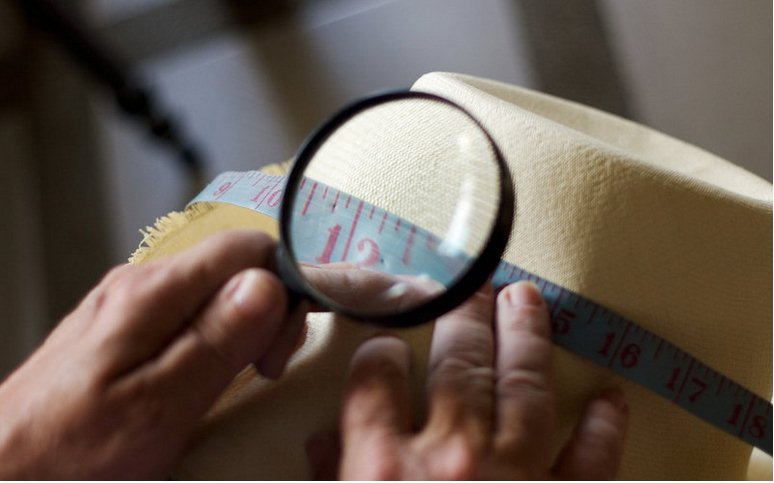
When the shoots of the toquilla palm are broken open they reveal a mass of greenish fibers — the "straw" from which the hats are made. After they've been split into fine threads, the fibers are briefly boiled, then hung out to dry. Roff Smith for NPR.
What he will state is that the hat he finished last year, and which required nearly a thousand hours of weaving, is the finest he has ever woven —indeed the finest he has ever seen or even heard of: a creamy-white, silky-fine masterpiece averaging an astounding 4,000 pin-neat herringbone weaves per square inch; a weave so fine you'd need a jeweler's loupe to count the rows. And each of them done by hand, by fingers alone; no loom is used in the making of a Panama hat.
He is equally emphatic when he says he will never attempt to weave a finer one. The strain on his eyes and the intense mental concentration was too much, even for a weaver of his skill and experience. "When you are weaving such fine straw, you cannot allow your mind to wander even for a second," he said through an interpreter. "When you weave, there is nothing in the world but weaving and straw."
He kept a log of the hours he spent weaving this one masterpiece hat.It came to just under a thousand, from the morning of June 19, 2013, when he began, to the 20th of February last year when he finished.
Espinal wove the hat at the behest of Hawaiian-based Panama hat dealer Brent Black, whom he has known for many years and who agreed to pay him a salary during his eight months of weaving, plus bonuses and the promise of a commission — likely to reach five figures — when the hat is eventually sold.
The difficulty with selling this particular hat is figuring out how to price it. One of Espinal's lesser hats, with about 3,000 weaves per square inch, went for $25,000, sold to a Hollywood figure who wanted something special to wear on his tropical honeymoon.
But this latest masterpiece is far more special. The degree of difficulty in weaving a Panama hat jumps exponentially as the weave count rises. A hat with 4,000 weaves per square inch is many, many times more difficult to weave than one with 3,000, and thus is also many times rarer. In fact, in 30 years of dealing in high-end Panama hats, Black had never before come across a hat with more than 3,000 weaves per square inch — and those he'd seen that were near that figure were all woven by Espinal.
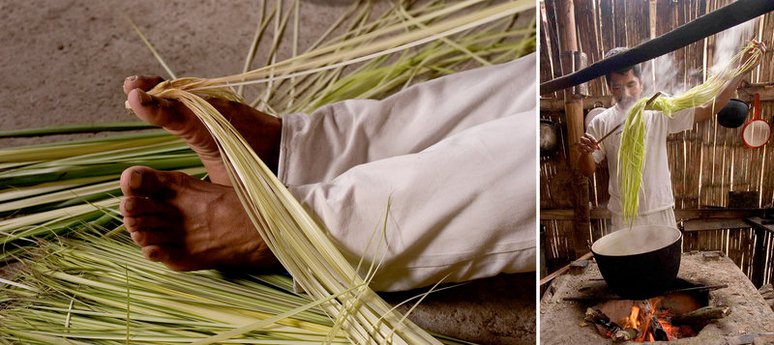
Weaving is only the first step. From the weaver the hat passes through the hands of a series of artisans with Hemingway-esque titles: the rematador,the cortador, the apeleador and the planchador. Roff Smith for NPR.
None of the old-time hat dealers in Montecristi, some of whose memories stretched back to the 1940s, could remember seeing anything that fine either.
Nor are they ever likely to again, says Espinal, who believes his masterpiece may well be the finest Panama hat ever woven. A modest, soft-spoken and rather shy man, he doesn't say this as a boast but as a simple home truth. Aside from the fact that weavers who can weave straw that fine are extremely rare — think of baseball players who can hit .400 over a season — there is the practical matter of the time it takes to weave a hat like that and the chances of something happening to it — a spilled drink or a bump or knock that tears the fabric. No weaver, with a family to feed, could afford to take that risk, he says, unless he was guaranteed payment regardless of how the hat turned out.
And nobody had ever done that before. Black made him the offer because he was curious to know just how fine a hat it was possible for the world's finest weaver to weave. Espinal accepted because he was curious about that himself. Now, having found out, he has no desire to repeat the performance. Once was enough. This hat is it.
"My hope is that it will go to a museum," said Black. "This is not a hat that should be on anybody's head. This is the very pinnacle of an old and very beautiful art."
A rather arcane art too, little understood by even the hat-wearing public. For one thing, Panama hats are not made in Panama — and they never were. They are made in Ecuador and always have been. Historically and traditionally, they come from the villages around Montecristi, a town of 15,000 about 90 miles up the coast from Guayaquil, although nowadays the overwhelming majority are made cheaply in the big commercial center of Cuenca, high up in the Andes.
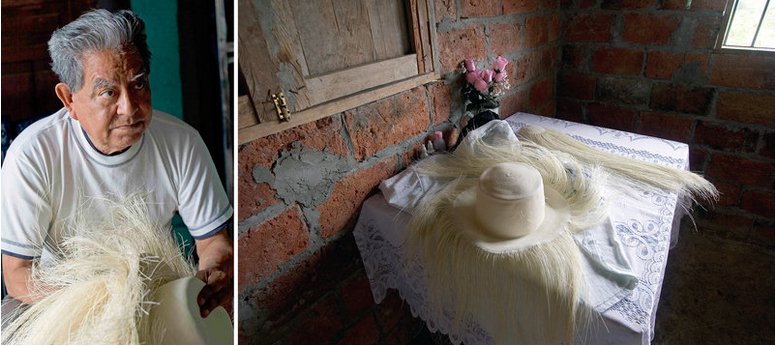
Don Rosendo Delgado, now in his late 80s, is one of the great old-time hat dealers. He says Simon Espinal's hats are among the finest — if not the finest — he's ever seen, though he recalls a female weaver from the 1950s who might have come close. Roff Smith for NPR.
Montecristi, with its age-old hat-weaving traditions and tiny output, remains the spiritual home of the Panama hat. Locals have been weaving extraordinarily fine hats out of toquilla straw for hundreds of years. The Spanish conquistadors even remarked on it when they passed through in the 16th century — although of course the hats weren't called Panamas back then.
That curious misnomer didn't come about until the early 19th century thanks largely to Manuel Alfaro, a 39-year-old exiled Spanish military officer who arrived in Ecuador in 1835 having fled Spain as a result of backing the wrong side in the Carlista Wars.
Adrift in the New World, he hit upon the idea of marketing the beautifully woven straw hats made around Montecristi. The hats were popular among sailors and travelers, but Alfaro had visions of scale. He organized the weavers and set up straw plantations to secure his supply, then went into the export business, shipping thousands of hats up north to the bustling seaports on the Isthmus of Panama.
Alfaro, Panama and the hats all hit the big time together in 1848, when the California Gold Rush saw tens of thousands of get-rich-quick prospectors swarming across the isthmus on their way to San Francisco and the gold diggings. A great many bought the jaunty straw hats. Light, cool and stylish, the hats provided shade against the tropical sun and yet could be rolled up and tucked in your pocket. Since Panama was where one bought thesesplendid straw toppers, guess what they came to be called?
By the 1850s Alfaro was exporting more than a quarter of a million hats a year and had become wealthy. Life got even sweeter after the Paris Exposition in 1855. A Frenchman who had been living in Panama presented Napoleon III with an extremely finely woven Panama hat. His Highness loved it. He wore it everywhere. Panama hats not only became in vogue but stayed there, an enduring gentleman's spring and summer fashion, the finer the weave the better.
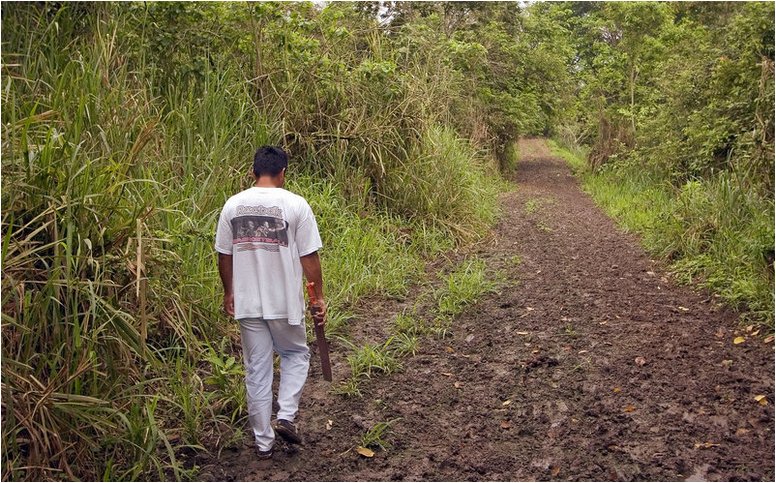
Panama hat weaver Simon Espinal hikes into the jungle, in the canton of Montecristi, Ecuador, to collect shoots of the toquilla palm, which containthe straw used to weave the headgear. Roff Smith for NPR.
Money was no object — not with the likes of J.P. Morgan, Edward VIII and Al Capone all being aficionados. A "Talk of The Town" piece in The New Yorker, from July 1930, breezily speaks of the thousand-dollar Panama on sale at Dobbs department store downtown — and this in an age when a factory-fresh Buick would set you back only $500.
"We used to get a lot of good business out of Cuba back in the '50s, before the revolution," recalls Rosendo Delgado, the doyen of old-time hat dealers in Montecristi. Now nearly 90, he has been dealing in Panama hats since he was a teenager, helping out in his father's and grandfather's hat business. "The rich sugar planters back then would think nothing of spending a couple thousand dollars to get the very best hats."
While there are still plenty of aficionados who will pay big money for a Montecristi superfino, there are few people left who are able to weave them. The old weavers have died or lost, through advanced age, the sharp eyes and nimble fingers required to weave the very best. For the most part their children have other aspirations.
"Hat weaving was seen as a peasant occupation," says Hawaiian-based Panama hatter Brent Black, who has spent the past 25 years trying to preserve the art. He became fascinated by the beauty and tradition of the dying art while on a trip to South America in the 1980s and eventually quit the advertising game to go into the hat trade himself, promoting the hats as examples of museum-quality South American woven art and the weavers themselves as artists, representing the few remaining master weavers and giving them commissions based on the final sales prices their hats achieved — a first in the world of Panama hats. Black has also established a weaving school in the village, which is supported by his nonprofit Montecristi Foundation.
"In Japan, an artisan who could weave like Simon would be regarded as a living treasure," he says. "In Ecuador, he's a peasant. There's something wrong with that."
Complicating the picture are the amount of fraud and chicanery in the Panama hat world and the scarcity of genuine Montecristi superfinos, of which only a few dozen, at most, are made each year. "Few people outside the trade have ever seen a really finely woven Montecristi," says Black, "although a lot of people think they have."
The big hat companies in Cuenca and Quito routinely sell commercial grade hats as "genuine" Montecristis, as do prominent hatters and hat shops around the world. Espinal, by contrast, makes perhaps three hats a year.
It isn't just scarcity and fineness of weave that distinguish a Montecristi Panama from the rest. It's an altogether different species of hat, from the intricate preparation of the straw to the pattern of weave itself. Montecristi's weavers, steeped in hat-making tradition, use the more artistic liso(herringbone) weave while those in the big commercial hat-weaving centers like Cuenca use the faster and lighter, economically efficient brisa weave. The liso weave is a tight, snug herringbone-patterned weave; brisa is a looser, square pattern.
Even more intriguing, and distinguishing, is the tag-team sequence of specialist artisans who apply the finishing touches to each Montecristi hat body and prepare it for blocking — specialists with romantic, Hemingway-esque titles such as the rematador, the cortador, the apeleador and theplanchador.
Indeed, the term rematador comes straight from the bullring — it is the "finisher," the one who dispatches a wounded bull, or in this case the specialist who performs the complex back-weave to seal the brim and conclude the weaving.
The cortador gives the hat the closest of shaves, trimming away any straw ends with a razor blade and the steadiest of hands, while the apeleador pounds the fabric of the hat with a rounded hardwood mallet to better align the fibers — a task that requires a nicety of judgment since too hard a blow can ruin the hat while being too gentle won't get the job done. The planchador, the last in the chain, gives the hat body a good firm going-over with an iron to help give it structure.
Ideally, a well-crafted Montecristi can be styled without the need of chemical stiffeners and glue, relying purely on the architecture of the straw. Its color — ideally antique ivory, never harsh white — should come from the sulfur smoking process the straw goes through during its preparation, not from chemical bleaching.
In fact, the overall process of making a Montecristi Panama hat is so distinctive that Black has been funding a campaign for UNESCO to award the hats Denomination of Origin status — a la French champagne or Parma ham. It is a protection the hat companies, who have been trading on the Montecristi name for years, have bitterly opposed. It may already be too late.
"Go into the hat shops in Montecristi itself these days and you find mass-produced hats from Cuenca being sold as genuine Montecristis," says Black, who has noticed an if-you-can't-beat-'em-join-'em resignation settling in over the artisans in Montecristi, who are increasingly adopting the time-saving shortcuts of the commercial hat companies, weaving not quite so finely and relying on bleaches and stiffeners to do the work of artisans of the past.
But not as yet in the holdout village of Pile, home to Simon Espinal and the other half-dozen or so other weavers still capable of turning out a true superfino. Most are middle age, if not older. It is an irony that in weaving hisgreatest-ever hat, arguably the finest Panama in a century, possibly ever, and never to be repeated, Simon Espinal may have touched the pinnacle of the art just at its very end.
Text and photos © 1988-2022, B. Brent Black. All rights reserved.
100% Secure Shopping









































